Introduction
In the pursuit of a healthier lifestyle, understanding the intricate relationship between weight loss and body measurements can be transformative. While many individuals focus solely on the numbers displayed on the scale, it’s essential to recognize that true progress often lies in the inches lost, reflecting changes in body composition and overall health.
This article delves into the significance of measuring success beyond weight, offering insights on how to effectively track progress, set realistic goals, and celebrate achievements that contribute to a holistic sense of well-being.
By embracing a comprehensive approach to health and fitness, individuals can unlock their potential and foster a culture of wellness that inspires and uplifts both themselves and those around them.
Understanding the Pounds to Inches Ratio in Weight Loss
As you begin your journey to shed pounds, it's essential to recognize that reducing size doesn't always correspond to a drop in body dimensions. On average, individuals may observe how many inches lost per pound, with a reduction of about 1 inch from their waist for every 5 to 10 pounds shed. However, this ratio, which indicates how many inches lost per pound, can fluctuate greatly depending on various factors, including body composition, gender, and specific fat distribution.
Significantly, women can acquire approximately 20 to 25 pounds of muscle throughout their lifting career, which can impact body composition changes during fat loss.
To improve your comprehension of this relationship, start by measuring key areas such as your waist, hips, and thighs before initiating your fat loss plan. By diligently tracking these measurements alongside your weight, you'll obtain a more holistic view of your progress. Keep in mind, the goal goes beyond simply shedding pounds; it's about transforming your body and greatly enhancing your overall well-being.
Foresight Health Coaching provides customized wellness services aimed at assisting you throughout this journey. Our corporate memberships cater to up to 30 employees and include:
- In-person wellness talks
- Comprehensive pantry and nutrition services
- White-glove service
- Access to our health and wellness app
For individuals, we provide one-on-one sessions tailored for high-performing athletes, also supported by our app.
Additionally, our workshops and webinars foster a community of learning and mutual support, covering topics such as effective stress management and advanced nutritional planning.
With personalized fitness coaching and nutritional guidance, our comprehensive programs are adaptable to your needs and delivered through our user-friendly app. This approach not only helps you achieve lasting lifestyle changes but also empowers you to stay motivated and committed throughout your journey. As noted by Sacks, F.M. in the POUNDS Lost Study, understanding dietary insights is essential for effective management of body mass.
Moreover, continuous support and engagement with healthcare professionals are essential for sustaining reduction in body mass over the long term, as emphasized in clinical guidelines. This holistic approach will ensure you have the tools and encouragement necessary to unlock your potential for a healthier life.
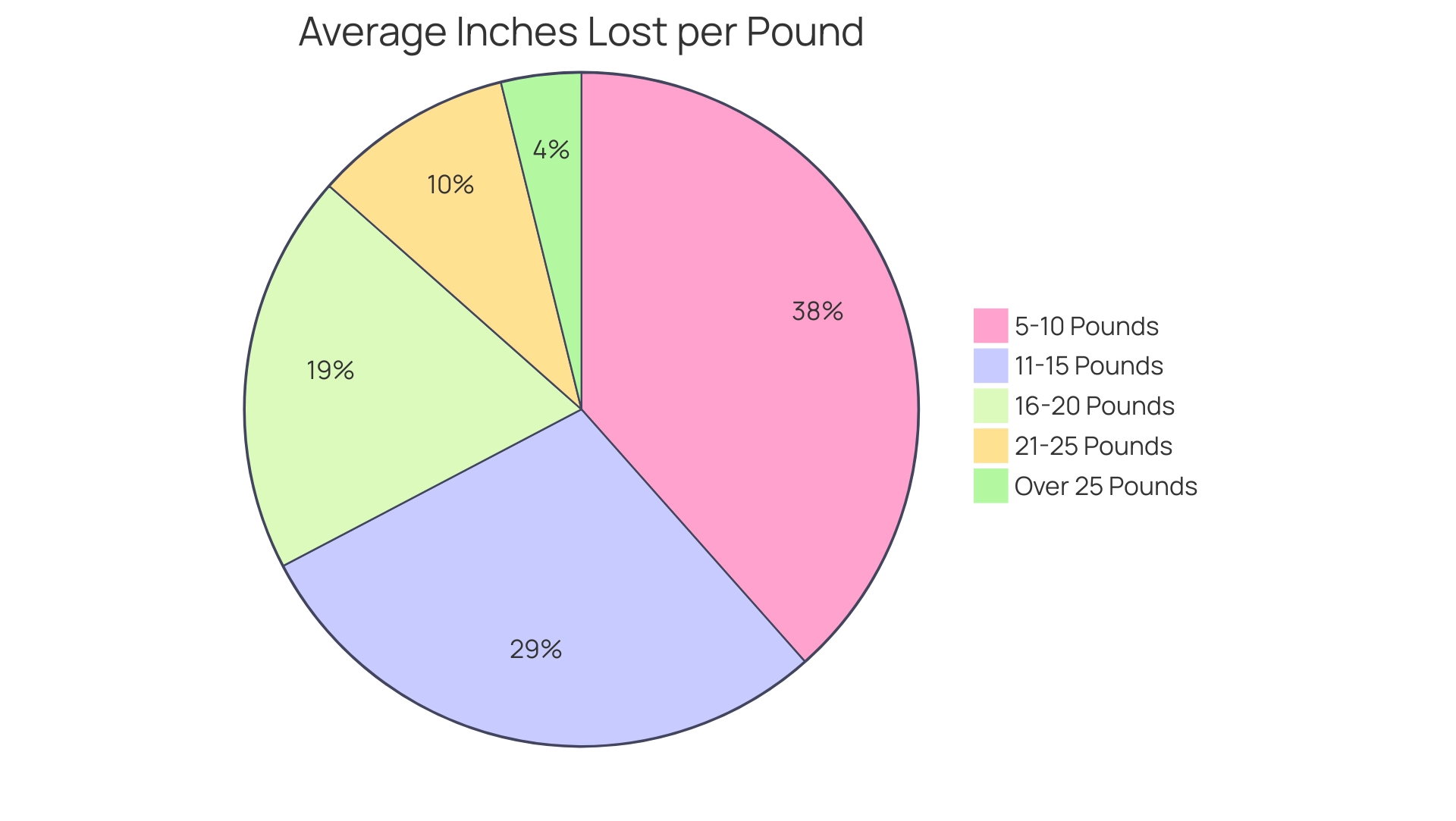
Why Losing Inches Can Be More Important Than Losing Pounds
Focusing on how many inches lost per pound rather than just pounds can illuminate a healthier transformation, as it often indicates a reduction in fat coupled with potential muscle gain. This shift in perspective is particularly crucial for individuals engaged in strength training, where muscle development can balance out fat loss on the scale, leading to weight plateaus. Such plateaus shouldn't discourage progress; instead, they signify positive changes in body composition.
For instance, a study of 5,435 individuals with type 2 diabetes mellitus (T2DM) found that the hazard ratio for risk of death associated with the highest waist circumference tertile was 2.11 compared to the lowest quintile, underscoring the implications of waist measurements. Furthermore, studies have indicated that waist circumference thresholds for recognizing increased cardiometabolic risk differ among various ethnic groups, highlighting the necessity for customized evaluations based on diverse populations. As fitness specialists highlight, measuring how many inches lost per pound offers a clearer view of wellness improvements and acts as a crucial vital sign to evaluate overall well-being.
One client shared, 'Since I started concentrating on my body metrics with personalized coaching, I've seen real changes in my health and confidence.' By embracing this mindset and fostering a culture of personalized coaching and evidence-based techniques within your team, you can celebrate these milestones that not only enhance physical performance but also inspire confidence and energy in daily life. This approach contributes significantly to creating a healthier workplace culture, where well-being is prioritized and recognized.
Let's discuss how our personalized coaching services can help you and your team thrive. Contact us today to schedule a consultation!
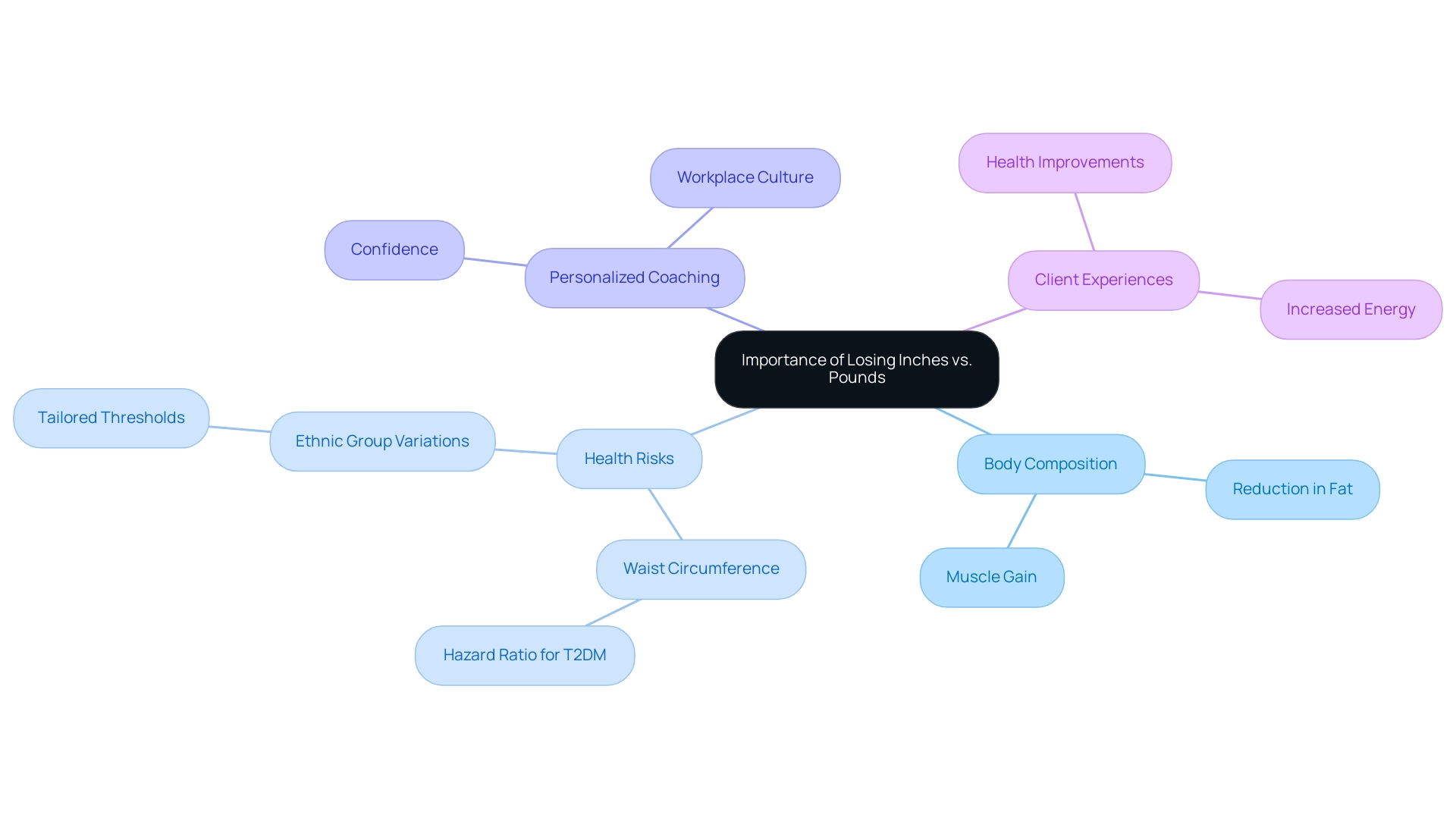
How to Measure Your Body for Accurate Tracking
Precise body assessment is a crucial step in effectively tracking how many inches lost per pound during weight loss. To ensure you get the best results, follow these essential steps:
- Begin with a flexible measuring tape, ensuring it is free from twists.
- For your waist, measure at the narrowest point, which is typically just above the belly button. It's important to note that women with a waist circumference greater than 35 inches are at a higher risk of heart disease and type 2 diabetes, making precise evaluation even more critical.
- To measure your hips, wrap the tape around the widest part of your hips and buttocks.
- For thigh dimensions, locate the midpoint between your hip and knee and take a reading there.
- It's essential to document these values consistently, whether on a weekly or bi-weekly basis, to track your progress effectively.
The case study titled 'Weekly Body Measurements' illustrates how clients are instructed to take readings at nine specific body sites, emphasizing the importance of consistency and technique.
Consistency is key—always measure at the same time of day and under similar conditions to ensure accuracy. As James Roland wisely advises,
When measuring, pull the tape measure tight — you don’t want it to be too loose or relaxed.
Additionally, be cautious of potential pitfalls in measurement practices, such as the appropriateness of using the paired t-test when comparing groups, which may require excluding incomplete measurements. By following these methods, you can attain dependable monitoring of your body circumference variations over time, which will help you determine how many inches lost per pound for successful reduction efforts.
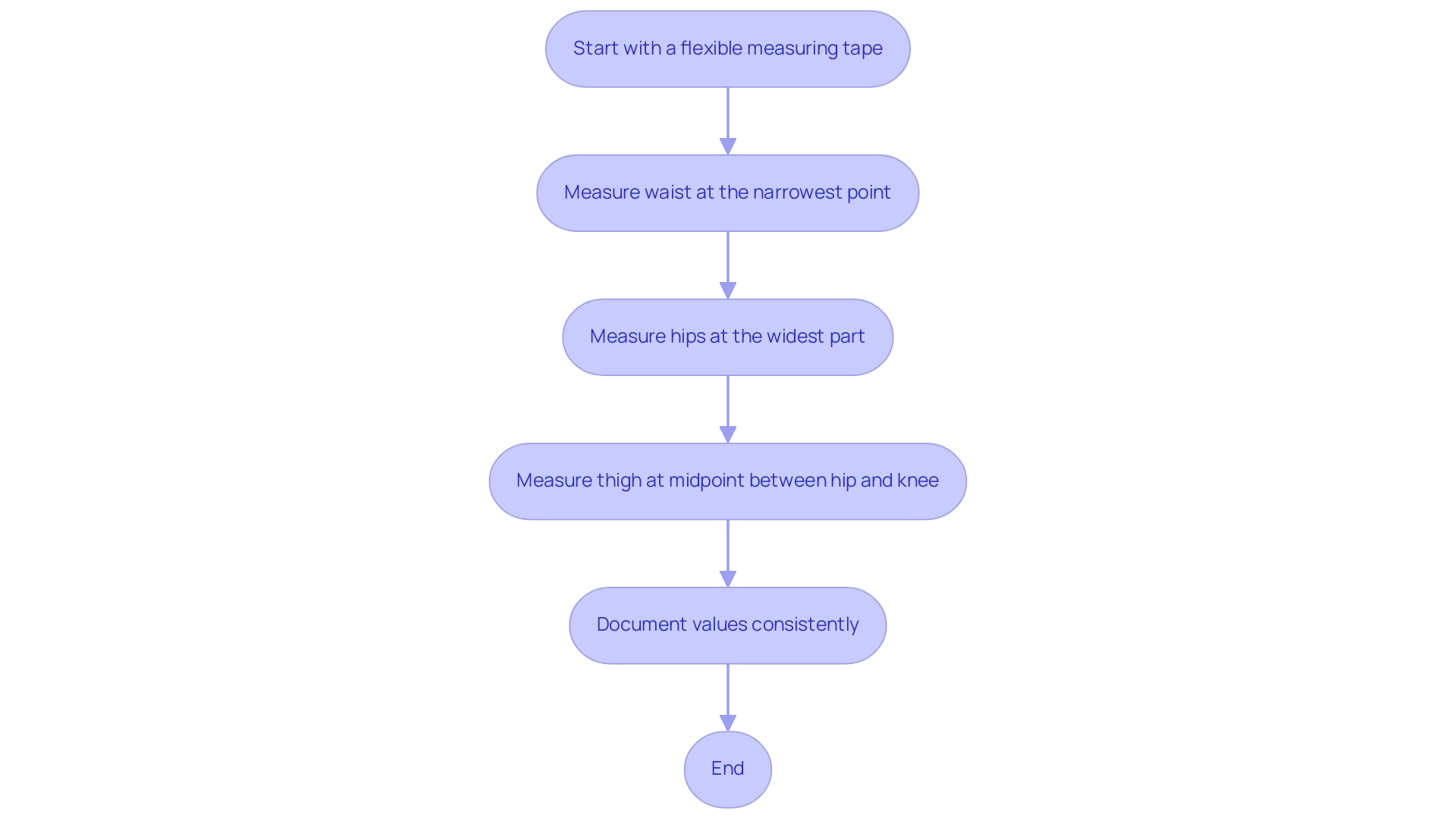
Setting Realistic Goals for Weight Loss and Inch Loss
Embarking on a weight loss journey can be both exciting and overwhelming, but setting realistic goals using the SMART criteria can pave the way for success. Start by making your goals Specific: clearly define what you want to achieve, such as losing 10 pounds or reducing your waistline by 2 inches. Next, ensure your goals are Measurable; tracking your progress through weekly weigh-ins and measurements will keep you accountable and motivated.
Aim for Achievable goals that are challenging yet realistic within your current lifestyle, allowing you to celebrate each milestone without feeling discouraged. It's essential that your goals are Relevant—align them with your broader wellness objectives, such as enhancing your fitness levels or boosting your energy. Finally, establish a Time-bound framework by setting deadlines, like aiming to lose 10 pounds in 3 months, creating a sense of urgency that drives commitment.
By adopting this organized method, you can create a clear pathway toward your health aspirations, motivating not just yourself but also your team to prioritize their well-being and achieve their wellness objectives. Remember, as you set these goals, consult your doctor and consider using the SMART method to set realistic, achievable goals. Notably, of the members with data available at 12 months, 69.1% were obese at the start, with a mean loss of 12.9%.
This highlights the importance of setting realistic goals. Furthermore, with Americans spending about $33 billion each year on diet products, it becomes clear that setting attainable goals is crucial for effective management of body composition. To further support your wellness journey, sign up for our free 7-day trial of the Foresight Health Coaching app.
Experience the transformative power of personalized wellness coaching, including tailored coaching plans and progress tracking features, and take the first step towards a healthier future for everyone.
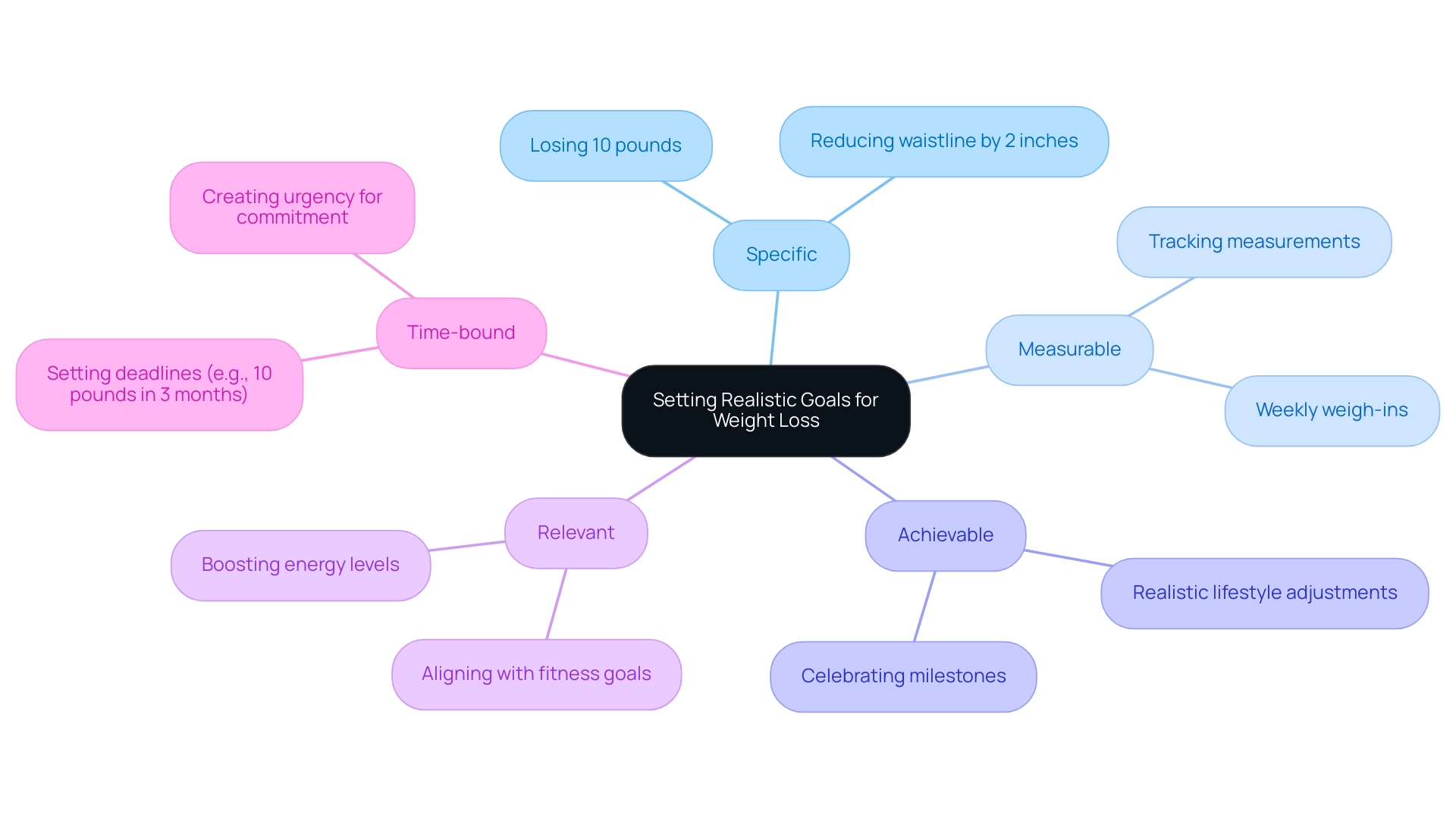
Celebrating Your Progress: Beyond the Numbers
Starting your journey towards a healthier lifestyle is not just about the figures on the scale; it's important to acknowledge every accomplishment along the way. With personalized coaching and experienced guidance, you will not only recognize how many inches lost per pound and the surge in your energy levels but also acquire valuable knowledge and skills necessary for a healthier life. These insights empower you to take control of your health and well-being, making improvements in your fitness and uplifting your mood vital aspects of progress.
A study on psychological reactions to increased mass emphasizes the significance of tackling emotional responses to control, which can improve adherence to reduction programs. Keeping a journal can be a powerful tool to document these victories, whether large or small, allowing you to reflect on your progress over time. Sharing your successes with friends, family, or support groups can amplify your motivation and create a sense of accountability, fostering an environment of encouragement.
Notably, research shows that the average weight loss at twelve months is around 5.0 lbs, which raises the question of how many inches lost per pound can indicate that even small changes can be significant. With the support of experienced coaches using evidence-based techniques, incorporating just-in-time adaptive strategies can provide timely motivation, making it easier to recognize and celebrate non-scale victories. By embracing the holistic benefits of your efforts, you will cultivate a positive relationship with your body and instill dedication to a healthier lifestyle.
As you celebrate these non-scale victories, remember that they play a critical role in your overall well-being and can significantly enhance your commitment to ongoing health improvements.
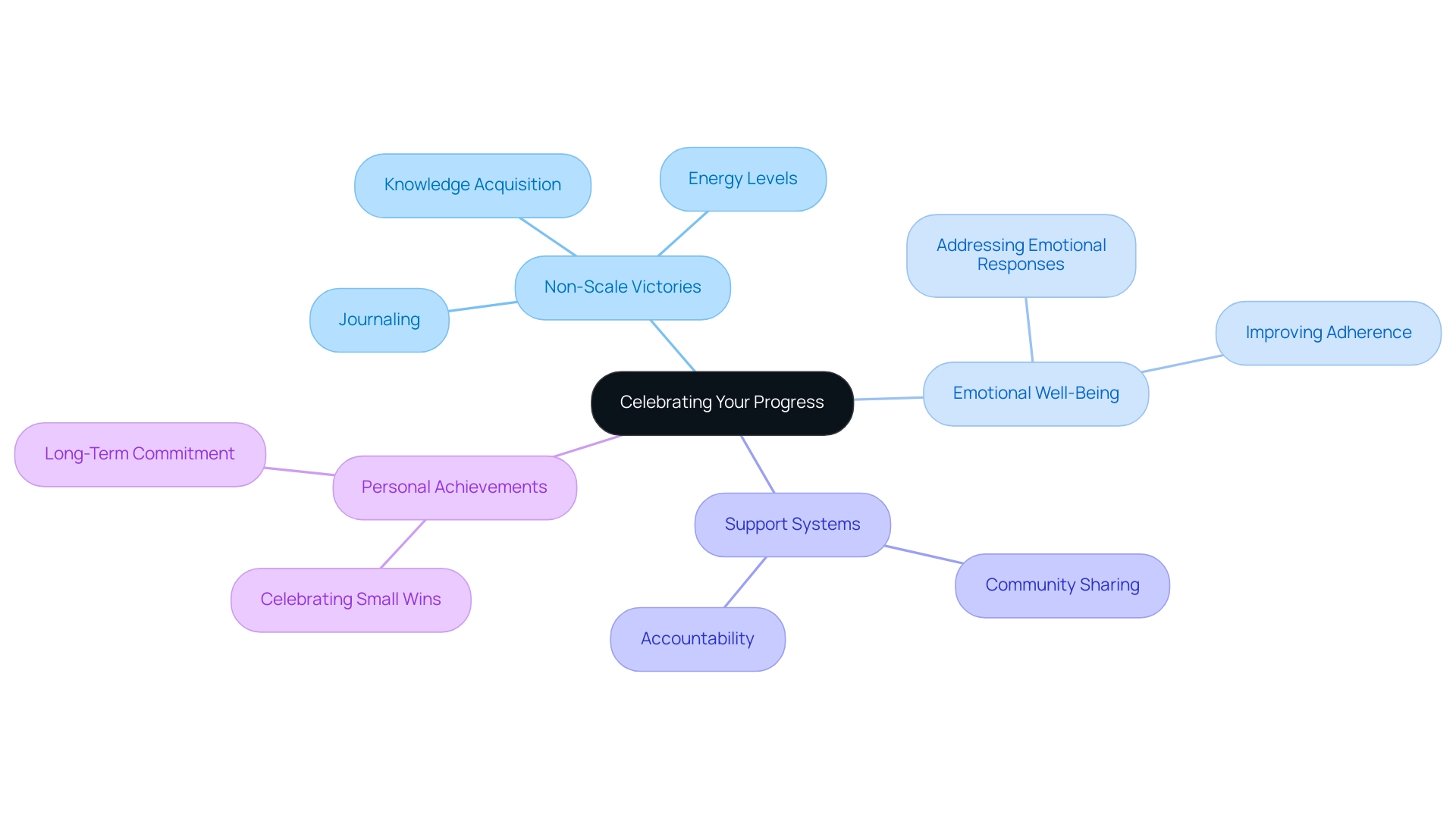
Conclusion
Recognizing the multifaceted nature of weight loss is essential for anyone striving for a healthier lifestyle. This article emphasizes that true progress is not solely defined by the scale but also by the inches lost, which often reflect positive changes in body composition and overall well-being. Understanding the pounds to inches ratio, setting realistic goals, and accurately measuring body dimensions are all critical components of a successful weight loss journey.
Celebrating achievements beyond mere numbers fosters a holistic approach to health. By focusing on body measurements and the insights gained from personalized coaching, individuals can experience transformative changes that enhance their physical and emotional well-being. The importance of a supportive environment, whether through personal accountability or community engagement, cannot be overstated. Each milestone, no matter how small, contributes to building a culture of wellness that inspires continued commitment and growth.
As the journey unfolds, embracing a comprehensive perspective will empower individuals to unlock their potential. By prioritizing health in all its forms—physical, emotional, and social—there lies an opportunity to cultivate a more vibrant and fulfilling life. Taking actionable steps today will pave the way for a healthier tomorrow, not just for oneself, but for everyone within the community.




